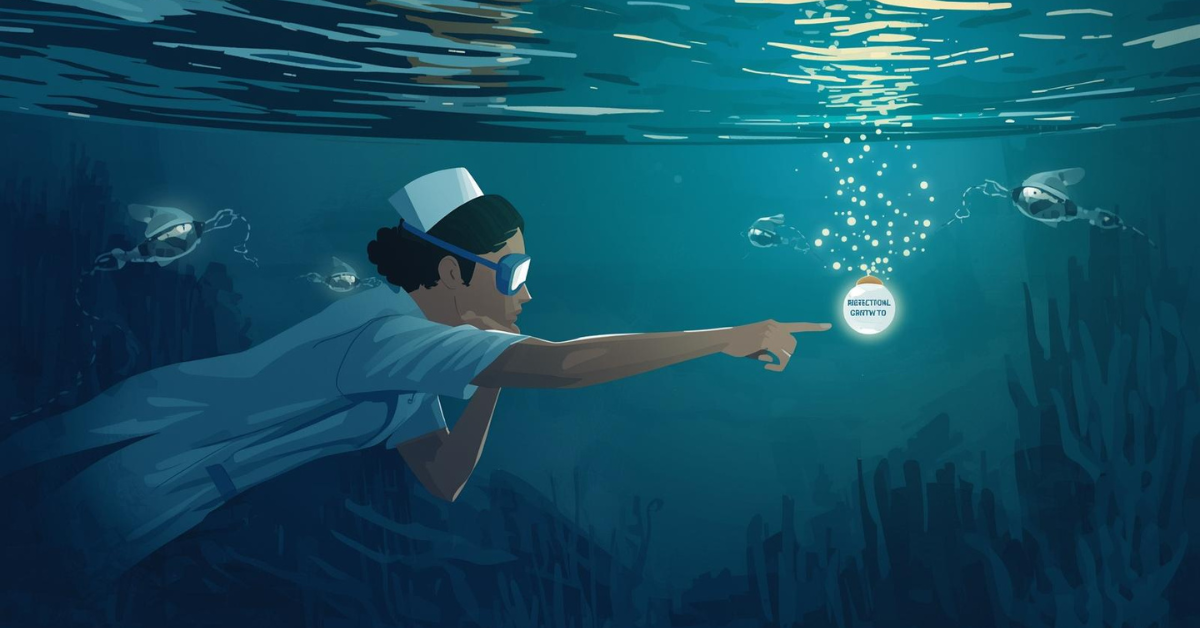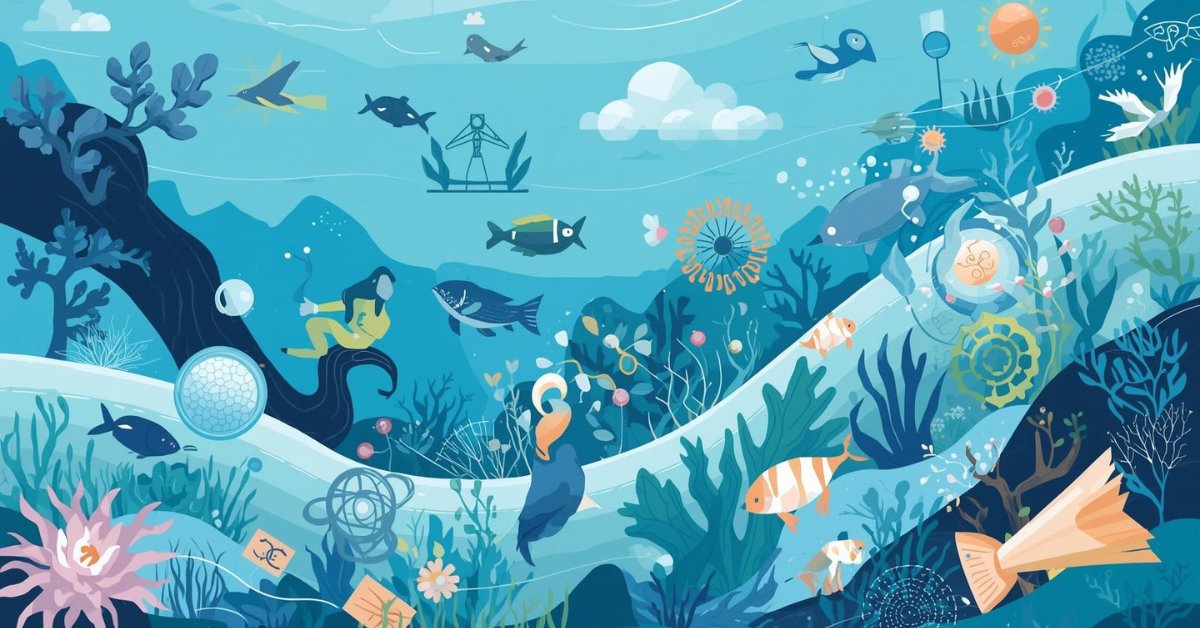The Perls or Diving for Perls in Nursing Education: From Reflection to Professional Growth. The phrase “Pearls or pearl diving in nursing education: from reflection to professional growth” refers to the use of reflective practice as a method for nurses to identify and develop key “pearls” or insights, and to “pearl diving,” which describes the active and intensive process of reflection for professional development.
From Reflection to Professional Growth: Perls or Diving for Perls in Nursing Education
This is supported by the acronym PEARLS, which stands for “Promoting Excellence and Reflective Learning in Simulation,” a specific framework used in nursing education to guide reflection following simulations.
Diving for PERLS in Nursing Education (BSN): Portfolio, Ethics, Research, Leadership & Self-Care
Meta Description: Discover how Professional Ethics, Research, Leadership & Self-Care combines the original “Portfolio of Evaluation for Reflection on Learning” with PERLS in BSN nursing. Look at semester-wise organization, templates, rubrics, and FAQs.
Slug: diving-for-perls-nursing-education-bsn-portfolio-ethics-research-leadership-self-care
Intro
“PERLS” appears in BSN programs with two very similar meanings. Historically, PERL stood for Portfolio of Evaluation for Reflection on learning—a mentoring, reflective approach using working and performance portfolios to develop professional ability. In many contemporary nursing curricula—including Pakistan’s modified BSN—PERLS is also understood as Professional Ethics, Research, Leadership & Self-Care, a competence set deliberately developed throughout a semester-long reflective project.
This post merges both concepts into one useful, teacher-friendly manual available for use in clinical, classroom, and assessment.
PERLS in BSN Nursing: What Does It Stand For?
- Original sensation (medical education):
- PERL—portfolio of reflection for learning evaluation
- Focus: reflective practice; mentorship; self-assessment; temporal progress
- Modern BSN sense
- PERLS is the Evaluation, Reflection, and Learning Summary portfolio.
- Also framed as Professional Ethics, Research, Leadership & Self-Care)
- Emphasis: developing professional identity via introspection and focused skills.
- The technique is portfolio-based reflection; the content is ethics, research, leadership, and self-care integrated across semesters.
Why PERLS Matters: The Payoff for Students and Programs
- Turning clinical days into learning: Reflection transforms experience into development.
- Develops professional identity by spotlighting ethics, responsibility, collaboration, and communication.
- Promotes evidence-based practice: Research literacy and EBP reflections link theory to care.
- Grows leadership capability by means of practiced and recorded delegating, conflict management, and inter-professional work.
- Resilient Self-Care
- Qualitative data support scores and OSCEs; they also document competence.
Five Essential Components of the PERLS Framework (Simple to Execute):
1) Divide Performance and Working Portfolios.
- Working Portfolio: critical events, private, in-progress reflections, feedback notes, goal sheets.
- Performance Portfolio: chosen “showcase” of finest effort used for viva/presentation/end-semester review.
Why it works: pupils take pride in displaying the polished set and feel free to be truthful in the work setting.
2) Create a Supportive Feedback Atmosphere
- Standardize regular, balanced feedback (specific strengths and specific improvements).
- Model reflection as faculty; share your own brief reflective notes.
- To make reflection a habit, do brief debriefs following clinical rotations.
3) Teach Self-Assessment & Goal-Setting
- Use basic cues: What went well? What didn’t? Why? What next?
- Compare self-ratings against mentor or peer comments to calibrate accuracy.
- Work with goal worksheets (Goal → Plan → Benchmark → Reflection).
- Show Development Over Time
- Use a semester-to-semester trail: depth increases, evidence grows, and goals change.
- Keep artifacts (early vs late reflections, repeated skills) to show progress.
5) Instructor for Arranged Autonomy
- Scheduled check-ins in little mentor groups of three to four students.
- Mentors lead reflection quality rather than just content mastery.
- Students come to own the reflective process more over time.
Semester-Wise PERLS Map (BSN 1–8): Focus & Sample Tasks
| Semester | Focus | Sample Portfolio Tasks |
| 1 | Foundations of reflection & professionalism | Learning style inventory; time-management plan; first reflection (Gibbs) on “first lab/first ward round”; academic honesty pledge |
| 2 | Early clinical skills & communication | “First patient” reflection; peer feedback sheet; critical incident narrative (privacy, consent, or empathy) |
| 3 | Ethical decision-making in practice | Case reflection on confidentiality or end-of-life communication; nurse–patient dialogue analysis |
| 4 | Teamwork & early leadership | Reflection on leading a bedside task; SBAR communication practice + feedback |
| 5 | Research literacy & EBP | 1 article critique (PICOT framing); reflection: “How evidence changed my plan of care” |
| 6 | Quality, safety & delegation | Root-cause reflection on a near-miss (de-identified); plan for improving handovers |
| 7 | Inter-professional collaboration | Reflection: “What I learned from working with physicians/allied health”; conflict resolution plan |
| 8 | Self-care & transition to practice | Professional identity statement; career plan; summative reflection; curated performance portfolio presentation |
How to Write a High-Quality Reflection (Gibbs’ Model)
- Description: What had occurred?
- Feelings: What were you feeling/thinking?
- Evaluation: Good vs not good.
- Analysis:
- In conclusion: What other actions might you do?
- Action strategy: What will you do next time?
Pro tip: Though weekly or bi-monthly, keep entries brief (200–300 words). Depth matters more than length.
Combining the Pillars: “Professional Ethics, Research, Leadership, & Self-Care”
A) Professional Values
- Subjects include confidentiality, permission, respect, cultural sensitivity, responsibility.
- Task suggestions: privacy breach prevention strategy, ethical vignette introspection, de-identified clinical scenario analysis.
B) Research (EBP Approach)
Topics: PICOT, appraisal fundamentals, translating data to practice.
- Tasks: mini critical evaluation; “Before versus After Evidence” reflection; EBP poster synopsis.
C) Command
- Themes include inclusive teamwork, delegating, conflict management, and communication models (SBAR).
- Task suggestions: forceful communication script, “I delegated…” micro-case, team briefing/debrief reflection.
D) Self-Care
Topics: boundaries, help-seeking, time blocking, stress management, resilience.
- Self-care plan, burnout early-warning checklist, “What restores me?” reflection define task ideas.
Evaluation and Rubrics: Basic, Open, Reliable
Suggested weightage; adjust as necessary:
Completion and Quality of Portfolios (40–50%)
- Depth of reflection (go beyond description)
- Clear objectives with accompanying evidence
- Consistency (entries made on schedule)
Viva/Showcase Presentation (20–30%)
- insight, professionalism, clarity
- Capacity to connect facts with expansion
- Professional Conduct (20-30%)
- Punctuality, participation, feedback sensitivity
For reflection entries, rubrics anchors:
Rising: descriptive, restricted analysis, no action plan
Developing: some research, a straightforward “why”, a little action step
- Proficient: excellent analysis, realistic action plan, integrates evidence and comments.
- Exemplary: measurable next steps, connects to ethics, EBP, leadership, and self-care, deep insight.
Sample Templates You Can Drop into Your Course
A) Goal-Setting Worksheet (One Page)
- Objective: Precise:
- Why this matters: Ethics/EBP/Leadership/Self- Care
- Organize (Resources, people, practice):
- Benchmarks: How I’ll know
- Deadline:
Date of check-in with mentor:
B) Weekly Reflection Card (200–300 words)
- Occurrence or experience this week:
- What performed effectively / not very well:
- Why ( investigation):
- Comments I got (patient surrogate / mentor / peer):
Action plan for following time:
C) Portfolio Table of Contents
- Title Page
- Semester Objectives
- Reflections ( chronologically)
- Mentored/peer feedback summaries
- Artifacts include certificates, logs, and de-identified instruments.
- Evaluation of oneself in mid-semester
- Reflection on the ultimate summary
- Mentor sign-off and grading rubric
Practical Advice for Busy Faculty: Make PERLS Sustainable
Ten to fifteen minutes in post conference for rapid reflections
- One folder per student using Google Drive or Docs or your LMS.
- Post weekly prompts in WhatsApp/LMS to lessen “blank page” fear.
- Peer pairs: Switch peer-feedback to grow mentorship.
- Calibration: At the start of the semester, complete a 30-minute faculty calibration on the rubric.
Schedule 2–3 fixed mentor clinics throughout the semester to help protect time.
Suggested Featured Image & Alt Text
- Image prompt for your designer/artificial intelligence software:
“Real nursing student showing a professional portfolio in a classroom; mentor hearing; hospital posters in backdrop; academic documentary approach; maroon and blue accents.”
- Alt tags:
“Nursing student presenting a reflective PERLS portfolio to a mentor in a classroom setting.”
Internal Linking Ideas (for SEO on NursesEducator.com)
- Link to your posts on Evidence-Based Practice, Nursing Ethics, Leadership in Nursing, Burnout & Self-Care, Portfolio Tips for Students, Reflective Writing Models.
- Add a sidebar widget: PERLS Resources (templates, rubric PDF, reflection prompts).
Short Excerpt (for archive/category pages)
Reflective portfolios with professional skills—Ethics, Research, Leadership, and Self-Care—are mixed in PERLS in BSN nursing. Understand the semester-wise map, templates, rubrics, and mentorship strategies to convert clinical days into lifetime learning.
Final Thoughts
PERLS is the attitude that changes daily care into professional development, not just yet another course. The framework for the portfolio method (working versus performance, feedback, mentorship, development over time) is the Ethics–Research–Leadership–Self-Care pillars supplying the content. Together, they produce reflective, evidence-based, resilient nurses suited for contemporary medicine.
Adopt PERLS intentionally; keep it basic and consistent; and see your pupils’ confidence—and competence—grow session by session.
FAQs
Q1. Is PERLS a theory subject or a practical activity?
It’s also this. Although PERLS is evaluated like a topic every semester, its essence is hands-on introspection: gathering data, creating brief reflections, and talking about development with mentors.
Q2. How do performance portfolios and working portfolios differ?
Private and raw (in-progress observations and comments) is the working portfolio. A gathered show you submit for assessment is the performance portfolio.
Q3. How frequently should pupils create reflections?
Weekly or biweekly short entries (200–300 words) are best; sustainable for pupils and simple for mentors to assess.
Q4. How should reflections be fairly graded?
Emphasize depth of analysis, match to objectives, evidence of feedback use, and clear action plans using a basic rubric (Emerging to Exemplary). Perform a short staff calibration session.
Q5. In PERLS, how do we bring research and EBP together?
Give one mini critical evaluation per semester and a “Before vs After Evidence” reflection demonstrating how literature influenced a treatment plan.
Q6. Students see introspection as “additional work.” Advice?
Build post-conference time for 10–15 minutes of introspection, offer cues, and restrict postings. Highlight successes in class and provide examples.
Q7. Can PERLS lessen burnout?
Yes—by educating self-care planning, boundary setting, and reflective emotional processing. Early on, students recognize stressors and develop practical coping mechanisms.
Q8. Students should include which artifacts?
Certificates from seminars, de-identified case summaries, checklists, peer-feedback forms, EBP posters, simulation lab reflections, and mentor sign-offs.
Q9. How can PERLS aid in leadership development?
A reflection on delegation, conflict resolution, SBAR drills, and team debriefs help to develop actual leadership abilities as well as give qualitative data for evaluation.
Q10. Can we do PERLS totally online?
Yes. Schedule mentor check-ins using video, record viva presentations, gather brief reflections and scanned artifacts, and set up a shared drive/LMS folder for each student.
References
1:Pinsky, L. E., & Fryer-Edwards, K. (2004). Diving for PERLS: Working and performance portfolios for evaluation and reflection on learning. Journal of General Internal Medicine, 19(5 Pt 2), 582–587. https://doi.org/10.1111/j.1525-1497.2004.30224.x
2:Dewey, J. (1938). Experience and Education. New York, NY: Macmillan.
3:Schön, D. A. (1983). The Reflective Practitioner: How Professionals Think in Action. New York, NY: Basic Books.
4:Kolb, D. A. (1984). Experiential Learning: Experience as the Source of Learning and Development. Englewood Cliffs, NJ: Prentice Hall.
5:Epstein, R. M., & Hundert, E. M. (2002). Defining and assessing professional competence. JAMA, 287(2), 226–235. https://doi.org/10.1001/jama.287.2.226
6:University of Health Sciences (UHS). (2023). Generic BSN Curriculum (2023–2024): Curriculum for Nursing Education in Pakistan. Retrieved from https://www.uhs.edu.pk/downloads/nursingcurri.pdf
7:Pakistan Nursing Council (PNC). (2023). National Competency Standards for Registered Nurses. Islamabad, Pakistan: PNC.
8:International Council of Nurses (ICN). (2021). ICN Framework of Competencies for the Generalist Nurse. Geneva: ICN.
Read More:
https://nurseseducator.com/didactic-and-dialectic-teaching-rationale-for-team-based-learning/
https://nurseseducator.com/high-fidelity-simulation-use-in-nursing-education/
First NCLEX Exam Center In Pakistan From Lahore (Mall of Lahore) to the Global Nursing
Categories of Journals: W, X, Y and Z Category Journal In Nursing Education
AI in Healthcare Content Creation: A Double-Edged Sword and Scary
Social Links:
https://www.facebook.com/nurseseducator/
https://www.instagram.com/nurseseducator/
https://www.pinterest.com/NursesEducator/
https://www.linkedin.com/company/nurseseducator/
https://www.linkedin.com/in/nurseseducator/
https://www.researchgate.net/profile/Afza-Lal-Din
https://scholar.google.com/citations?hl=en&user=F0XY9vQAAAAJ



Turkey private tours Turkey vacation packages are comprehensive. Every detail was planned and executed perfectly. https://bushmansafaris.com/?p=17891
Tisel Technics — официальный дистрибьютор складской техники с одним из самых широких каталогов: от ручных и самоходных тележек до ричтраков, электрических и дизельных погрузчиков. 197 моделей, тест-драйв на вашем складе, аренда и лизинг, подбор запчастей и сервис в 53 сертифицированных центрах по России. Узнайте детали, акции и условия гарантии на https://tiseltechnics.ru/ Действуют расширенная гарантия до 4 лет и видеодемонстрации техники прямо со склада для быстрого выбора.
купить диплом в магадане [url=https://www.rudik-diplom13.ru]купить диплом в магадане[/url] .
Современные боты для поиска информации становятся всё более востребованными.
Они помогают изучать открытые данные из интернета.
Такие боты применяются для аналитики.
Они могут быстро обрабатывать большие объёмы контента.
бот глаз бога авто
Это позволяет сформировать более точную картину событий.
Многие системы также обладают инструменты фильтрации.
Такие сервисы активно применяются среди специалистов.
Эволюция технологий позволяет сделать поиск информации доступным и быстрым.
abc123123123123